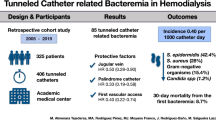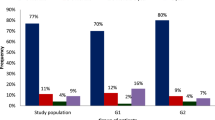Abstract
The number of patients with end-stage renal disease (ESRD) treated with hemodialysis (HD) increases annually globally. One of the main factors determining the quality of their lives is the type of vascular access used. Tunnel catheters have entered the medical practice since 1987. Regardless of the recommendations for their use in up to 10% of hemodialysis patients, their relative share has risen in the last two decades two to three times in the countries of Europe, and in the USA and Canada, they represent over 40% of the access for hemodialysis treatment. The current literature review aims to present the main complication in their use—catheter-related infections. The different types of infectious complications, their pathogenesis, their laboratory diagnostics, and practical guidelines for the behavior of each of them are examined.



Similar content being viewed by others
References
Mermel LA (2000) Prevention of intravascular catheter-related infections. Ann Intern Med 132(5):391–402
O’Grady N, Alexander M, Burns L et al (2011) Guidelines for the prevention of intravascular catheter-related infections. Clin Infect Dis 52(9):e162–e193
United States Renal Data System (1999) Annual Data Report: part VI. Causes of death. Am J Kidney Dis 34:87–94
United States Renal Data System (1999) Annual Data Report: part IX. Hospitalization in ESRD. Am J Kidney Dis 34(1999):114–123
Oliver M (2001) Acute dialysis catheters. Semin Dial 14(6):432–435
Saxena A, Panhotra B (2005) Hemodialysis catheter-related bloodstream infections: current treatment options and strategies for prevention. Swiss Med Wkly 135(9–10):127–138
Dimick J, Pelz R, Consunji R et al (2001) Increased resource use associated with catheter-related bloodstream infection in the surgical intensive care unit. Arch Surg 136(2):229–234
Oliver M, Callery S, Thorpe K et al (2000) Risk of bacteremia from temporary hemodialysis catheters by site of insertion and duration of use: a prospective study. Kidney Int 58(6):2543–2545
Saxena A, Panhotra B, Naguib M (2002) Sudden irreversible sensory-neural hearing loss in a diabetic on hemodialysis, receiving amikacin as antibiotic-heparin lock. Pharmacotherapy 22(1):105–108
Raad I, Hanna H, Maki D (2007) Intravascular catheter-related infections: advances in diagnosis, prevention, and management. Lancet Infect Dis 7(10):645–657
Mermel L, Farr B, Sherertz R et al (2001) Guidelines for the management of intravascular catheter-related infections. Clin Infect Dis 32(9):1249–1272
Maki D, Weise C, Sarafin H (1977) A semiquantitative culture method for identifying intravenous-catheter-related infection. N Engl J Med 296(23):1305–1309
Bouza E, Alvarado N, Alcala L et al (2005) A prospective, randomized, and comparative study of 3 different methods for the diagnosis of intravascular catheter colonization. Clin Infect Dis 40(8):1096–1100
Bouza E, Alvarado N, Alcala L et al (2007) A randomized and prospective study of 3 procedures for the diagnosis of catheter related bloodstream infection without catheter withdrawal. Clin Infect Dis 44(6):820–826
Cheesbrough J, Finch R, Burden R (1986) A prospective study of mechanisms of infection associated with hemodialysis catheters. J Infect Dis 154(4):579–589
De Cicco M, Campisi C, Matovic M (2003) Central venous catheter related bloodstream infections: pathogenesis factors, new perspectives in prevention and early diagnosis. J Vasc Access 4(3):83–91
Farber B, Kaplan M, Clogstron A (1990) Staphylococcus epidermidis extracted slime inhibits antimicrobial action of glycopeptide antibiotics. J Infect Dis 161(1):37–40
Foster T, McDevitt D (1994) Surface-associated proteins of Staphylococcus aureus: their possible roles in virulence. FEMS Microbiol 118(3):199–205
Patti J, Allen B, McGavin M et al (1994) MSCRAMM-mediated adherence of microorganisms to host tissues. Annu Rev Microbiol 48:585–617
Adeniyi O, Tzamaloukas A (2003) Relation between access-related infection and pre-infection serum albumin concentration in patients on chronic hemodialysis. Hemodial Int 7(4):304–310
Butterly D, Schwab S (2000) Dialysis access infections. Curr Opin Nephrol Hypertens 9(6):631–635
Chang C (2004) Infective endocarditis in maintenance hemodialysis patients: fifteen years’ experience in one medical center. J Nephrol 17(2):228–235
Wagener GAM, Miller J, Muder R (1998) Risk of infection due to central venous catheter: effect of site of placement and catheter type. Infect Control Hosp Epidemiol 19(11):842–845
Saxena A, Panhotra B, Naguib M et al (2002) Septicemia in hemodialysis: a focus on bacterial flora and antibiotic access salvage. Saudi J Kidney Dis Transplant 13(1):29–34
Saad T (1999) Bacteremia associated with tunneled, cuffed hemodialysis catheters. Am J Kidney Dis 34(6):1114–1124
Oliver M, Edwards L, Treleaven D et al (2002) Randomized study of temporary hemodialysis catheters. Int J Artif Organs 25(1):40–44
Wivell W, Bettmann M, Baxter B et al (2001) Outcomes and performance of the Tesio twin catheter system placed for hemodialysis access. Radiology 221(3):697–703
Miller L, Clark E, Dipchand C et al (2016) Hemodialysis tunneled catheter-related infections. Can J Kidney Health Dis 3:2054358116669129. https://doi.org/10.1177/2054358116669129
Chan K, Warren H, Thadhani R et al (2012) Prevalence and outcomes of antimicrobial treatment for Staphylococcus aureus bacteremia in outpatients with ESRD. J Am Soc Nephrol 23(9):1551–1559
Capdevila J, Segarra A, Planes A et al (1993) Successful treatment of haemodialysis catheter-related sepsis without catheter removal. Nephrol Dial Transplant 8(3):231–234
Beathhard G (1999) Management of bacteremia associated with tunneled-cuffed hemodialysis catheters. J Am Soc Nephrol 10(5):1045–1049
NKF-K/DOQI (2006) clinical practice guidelines for vascular access: update 2006. Am J Kidney Dis 48(Suppl. 1):S176–S322
Mermel L, Allon M, Bouza E et al (2009) Clinical practice guidelines for the diagnosis and management of intravascular catheter-related infection: 2009 update by the Infectious Diseases Society of America. Clin Infect Dis 49(1):1–45
NKF-DOQI clinical practice guidelines for vascular access (1997) National Kidney Foundation-Dialysis Outcomes Quality Initiative. Am J Kidney Dis 30(4 Suppl. 3):S150–S191
Vanholder R, Canaud B, Fluck R et al (2010) Diagnosis, prevention and treatment of haemodialysis catheter-related bloodstream infections (CRBSI): a position statement of European Renal Best Practice (ERBP). Nephrol Dial Transplant 3(3):234–246
Fortun J, Grill F, Martin-Davila P et al (2006) Treatment of long-term intravascular catheter-related bacteraemia with antibiotic-lock therapy. J Antimicrob Chemother 58(4):816–821
McConnel S, Gubbins P, Anaisse E (2004) Are antimicrobial-impregnated catheters effective? Replace the water and grab your washcloth, because we have a baby to wash. Clin Infect Dis 39(12):1829–1833
Trerotola S, Johnson M, Shah H et al (1998) Tunneled hemodialysis catheters: use of a silver-coated catheter for prevention of infection–a randomized study. Radiology 207(2):491–449
Rabindranath K, Bansal T, Adams J et al (2009) Systematic review of antimicrobials for the prevention of haemodialysis catheter-related infections. Nephrol Dial Transplant 24(12):3763–3774
Author information
Authors and Affiliations
Corresponding author
Ethics declarations
Conflict of Interest
The authors declare that they have no conflict of interest.
Additional information
Publisher’s Note
Springer Nature remains neutral with regard to jurisdictional claims in published maps and institutional affiliations.
Rights and permissions
About this article
Cite this article
Borisov, B., Linkova, S. Infectious Complications of Hemodialysis Tunneled Catheters—Types, Diagnosis, and Treatment Strategies. Indian J Surg 82, 460–464 (2020). https://doi.org/10.1007/s12262-020-02095-0
Received:
Accepted:
Published:
Issue Date:
DOI: https://doi.org/10.1007/s12262-020-02095-0




